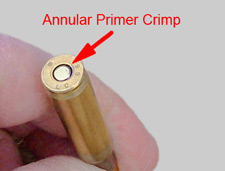- 01: Introduction
- 02: History
- 03: Propellants, Firearms, and Ammunition Development
- 04: Modern Firearms Manufacture
- 05: Small Arms Ammunition
- 06: Evidence Handling Procedures
- 07: Equipment and Instrumentation
- 08: Examination of Firearms
- 09: Cartridge and Shotshell Examination
- 10: Characterization and Evaluation of Fired Projectiles
- 11: Bullet Comparison and Identification
- 12: Gunshot Residue and Distance Determination
- 13: Toolmark Identification
- 14: Communicating Results
- Resources


Priming
Home > Small Arms Ammunition > Centerfire Ammunition > Priming
Cases that do not have a flashhole opened during case manufacture are candidates for off-line priming using the pierce-and-prime machine. Cases are fed into a large rotating dial that grips each case firmly and moves it through the priming process. The workstation is fitted with a heavy-duty sharp punch beneath the dial. As the case stops at the station, a hollow backer punch enters the case to hold it down and the sharp punch moves up. It strikes the center of the primer pocket and produces a flashhole of the correct diameter. Both punches are withdrawn and the case moves to the next workstation.
After the operator has confirmed that the case is ready, it moves to a priming station. The case is still seated upright in the dial. Primers are fed through a magazine to a position directly under the case. A lower punch rises, picks up a primer, and pushes it into the case while a backer punch enters the case mouth to provide support for accurate seating.
After priming, a sealant is added to the narrow circular depression formed where the primer meets the case. A single drop of liquid acetate or other suitable material is applied to one side of the pocket; capillary action wicks the liquid to fill the depression.

In addition to being sealed, military ammunition primers used in semiautomatic rifles or fully automatic weapons must be further secured in place beyond the usual frictional fit by annular crimping or staking. Without such measures, chamber pressures may force the primer backward out of position causing the weapon to malfunction.
Annular primer crimps alter the entire edge of the primer pocket. A hollow steel tube, slightly larger than the primer pocket, is centered over the pocket and force is applied. The resulting rim of brass that overhangs the primer ensures a secure lock.
Staking accomplishes the same purpose in a different way. Three small indentations spaced 120 degrees apart surround the primer pocket in the base of a cartridge case containing the primer. Staking can be observed in some forms of foreign military ammunition.




